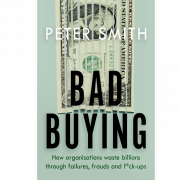Procurement “Transformation” and Supply Base Reduction
I’ve had a couple of abortive attempts at writing a book about “procurement transformation”. Perhaps one day it will happen. But my feeling over the years is that often presentations at conferences that claim to be about “transformation” are nothing of the kind. They might be about upskilling the function; or implementing a new piece of software; or launching a category management programme; but the ideas they describe are not really transformative. And in some cases, the central aim or achievement of the programme appears to be simply a reduction in supplier numbers.
There is no doubt that many organisations do have a supply base which is too large to achieve optimal performance or value. So a reduction in supplier numbers can be beneficial – but the point is that it is usually not appropriate to consider supplier reduction as an end in itself. Rather it should be seen as one of the outcomes of a wider procurement improvement or transformation programme.
An excessively large supply base usually develops because of a lack of procurement spend visibility, control or influence. Budget holders decide where and how to allocate their money, leading to fragmented and un-coordinated spend. Hence getting such situations under better management will bring a number of benefits, and an effective procurement programme, probably category management based, will be needed to address matters. And even today, most organisations, in most categories, will find that the result of a well-planned and executed sourcing programme is fewer suppliers in that area.
So supplier reduction as an outcome of an appropriate programme can indicate real benefits have been achieved. Fewer suppliers means more concentrated spend, and there can be benefits from this aggregation. Although economies of scale are over-estimated in many industries and sectors, it is clear that when most organisations look carefully at a category, and find dozens or hundreds of suppliers, they derive benefits when they come to negotiate with a view to reducing that number.
But in some cases, the “right” answer once a spend category is considered will be more suppliers, not fewer. If the analysis shows that the organisation is worryingly dependent on certain suppliers, then that should be the desired approach, for instance. My personal baptism in procurement was a role where I was at the mercy of a monopoly supplier of a vital raw material. It was not a good place to be and I longed for “supplier increase” rather than supplier reduction!
Or even if risk is not the issue, there may be value opportunities through taking a more aggressive and tactical approach to a market, with frequent supplier switching. We should not be afraid of strategies that lead to more suppliers – as long as the benefits are weighed against the true costs of supplier management into account. So here is a summary of key points to consider.
- Supplier reduction should be a potential outcome from doing procurement well. It is rarely sensible as an objective or end in its own right, and it is not the most appropriate strategy for every occasion.
- Understanding the starting point or baseline is important for any major procurement improvement initiative. And if supplier reduction is part of the business case, it is vital to have a clear and accurate view of the baseline. Supplier numbers are often overstated, though duplication or mis-categorisation, so a spend analysis maybe required as a starting point.
- Similarly, if the savings from supplier reduction are going to form part of the business case for a procurement programme, the true cost of managing suppliers needs to be assessed, as well as realistic savings form any re-negotiations, so any savings can be calculated with realism and as much accuracy as possible.
- For any category, and certainly before any supplier reduction initiatives are set in train, procurement must ensure that there is a good understanding of the markets, suppliers and associated risks that are being addressed.
- Supplier reduction can be a sensitive issue amongst stakeholders and budget holders, who may see their favourite suppliers disappear. The benefits of rationalisation programmes may not be very visible to stakeholders either. So it is important to get the buy-in of your key stakeholders and engage them in the process, particularly if you are trying to make dramatic change.
That last point is important but often disregarded. Managing the internal stakeholder dimension is often more challenging for procurement than managing external markets, and needs significant focus. That is always true, but particularly applies when a major change in the supply base is likely. Indeed, I’ve seen that point in itself be enough to kill procurement change or transformation programmes stone dead.









Leave a Reply
Want to join the discussion?Feel free to contribute!